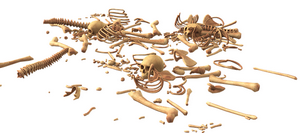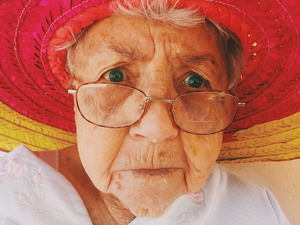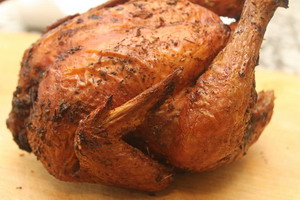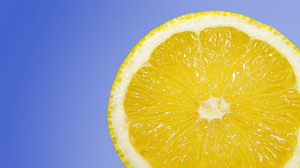Ellen bought an online program for helping her osteoporosis last week. This put the whole subject of osteoporosis into my head for a bit. Then I read an article on protein requirements for humans relative to the whole paleo movement – more fodder for my brain. Something in that article kept rolling around in the back of my brain. That piece was that our consumption of collagen did not count towards our protein need since it was an incomplete protein and did not help us form new muscle tissue. Our need for collagen is in fact a completely separate need from our usual protein need even though collagen is made from protein.

About 1:30 in the morning that next morning I awoke with a crazy idea that I decided I needed to get up and write down before I forgot it. That idea was that osteoporosis was not actually a calcium deficiency issue at all, but was really a collagen metabolism problem. The thought arose because babies and small children have very low levels of calcium in their bones, and their bones are rubbery, not brittle. Their bones are more collagen than minerals. So maybe the real issue with osteoporosis was not enough collagen in the bones.

Most everyone is aware of collagen because of its importance for skin, hair, and nails. The reason we look older is because the collagen in our skin decreases allowing the skin to sag. What if osteoporosis is just another type of collagen deficiency disease like aging skin? I spent the next 2 hours researching collagen in lieu of sleeping. As far as I can tell, no one is looking at this in the mainstream. There are hardcore research studies on this subject, but no one seems to be paying attention. Several studies that have looked at supplemental collagen have shown a significant improvement in osteoporosis. We may be on to something.
My collagen research told me that there are actually 28 kinds of collagen. The types most important for humans are types I, 2, 3, 5, and 10. For bones it is mostly the type 1. But bones are just the tip of the iceberg. Collagen holds everything together in our body. It accounts for 25% to 35% of the total protein in the body. Collagen not only forms the basis of our bones, but also our joint cartilages, ligaments, tendons, the linings of all our organs and blood vessels, the connective tissue holding all our parts where they are, plus of course our skin, hair, and nails.

Now here is the problem. In this country we don’t eat collagen hardly at all. Collagen is the gristle in meat, the cartilage on the bones, the stuff we throw away when we eat meat. Other cultures and countries prize these foods, but we think they are gross, so we don’t eat them. About the only collagen we eat is in the form of Jello, and that is mostly sugar and food coloring. Yes, gelatin is collagen. As a culture we are severely collagen deficient even though we eat way more muscle meat protein than we need. Health food faddists have been getting onto the collagen bandwagon the last couple years in the form of bone broth. This is probably the best benefit to come from the paleo food camp. But bone broth is primarily just type 1 collagen. I want a good source of all the major collagens for humans in a form that is easily absorbed.
Absorption is a big issue, as gelatin and most natural sources of collagen are huge molecules that require strong digestion to break down, which most people don’t have anymore. Bone broth is really good for you because of the collagen, but you still have to be able to efficiently digest it to get the value from it. Modern collagen supplements get around this by pre-digesting the collagen through a process called hydrolysis. This breaks the collagen down into single, double and triple peptides. Compare this to a typical type 1 collagen molecule that has 3150 peptides (amino acids) bound together. That is why hydrolyzed collagen is 95% absorbed while standard collagen absorption varies from 10% to 40%.

Where is this leading us? The obvious answer is that we need to be eating more collagen. Forget those skinless chicken breasts. We want the skin because of the collagen in it. We want to chew on the cartilage end caps of the bones. We want to make bone broth based soups. Even then we are not going to get enough unless we are willing to eat every bit of the animals we harvest, and not just the muscle meats. Muscle meats are good for stimulating growth by stimulating the mTOR metabolic pathway. This is important occasionally, but chronically stimulating this pathway burns us out and we die earlier. Suppressing this pathway is the main technique currently known for lengthening lifespan. Collagen does not promote this pathway, only muscle meats and branched chain amino acids do.
To promote more elastic younger looking skin, increase bone strength, reverse joint disease, make hair and nails stronger, and live longer we need more collagen. For most of us that means supplemental collagen. How much do we need? One author I respect says he makes sure to get an average of 40 grams of collagen a day. The studies on bone health found a minimum of 10 grams a day was needed to show a positive effect. Either way this is too much to be able to take it in pill form. That means a powdered supplement. Fortunately the market is catching up with our needs. When I first started playing with collagen many years ago, finding good sources of collagen was difficult and I had to buy each of the different types separately. When I thought of doing this article I thought I would have to do that and mix it together to create a complete supplement for my

patients. OrthoMolecular Products makes a really top of the line product called CollaGEN, which I should have in the office. A check of what is now available on Amazon shows me that nice combinations are available now for a price that is lower than I could create the blend from scratch. Several options exist, and the one I just bought to try is this…https://amzn.to/2CY1BCA. It is pretty neutral tasting, so I am mixing it into my morning colostrum smoothie along with my Better Bladder and my longevity formula. That is a massive load of nutrients to start my day.
One point I have not focused on is the importance of collagen for injury repair. In particular the type of injuries I see in my practice are especially relevant. Simple muscle strains don’t usually need extra nutrition since they are repaired with the type of protein we normally eat. But when ligaments and tendons are injured through high impact trauma (like a car crash), or through repetitive stress injuries like we see with heel tendonitis, then we need collagen for these repairs. I am thinking that I will now recommend collagen with all my auto injury cases as well as any patients that seem to have difficulty holding their adjustments. Chronically unstable joints are most likely weak supportive tendons and ligaments.

An extra point of understanding is that the cells of the body that turn collagen into our tissues need lots of vitamin C, Zinc, trace minerals, B vitamins, and so on are also needed, but the big one is the C. So be sure to take extra C if you want to get the value out of your collagen supplement. Use hydrolyzed collagen to ensure absorption, and I would take 10 to 20 grams per day everyday and more if you have an injury or health concern like degenerated joints or osteoporosis.
I have also found some other new stuff for osteoporosis that I will write about in another newsletter soon.
